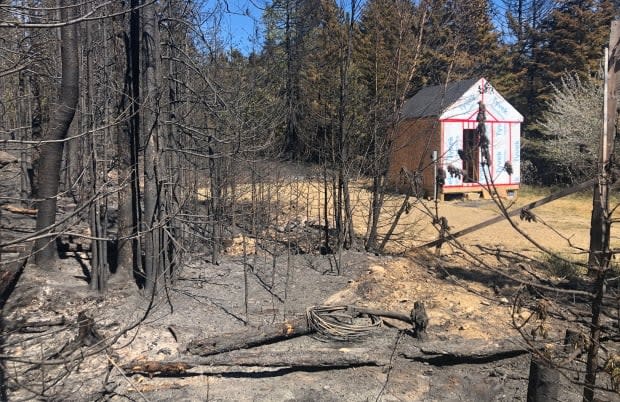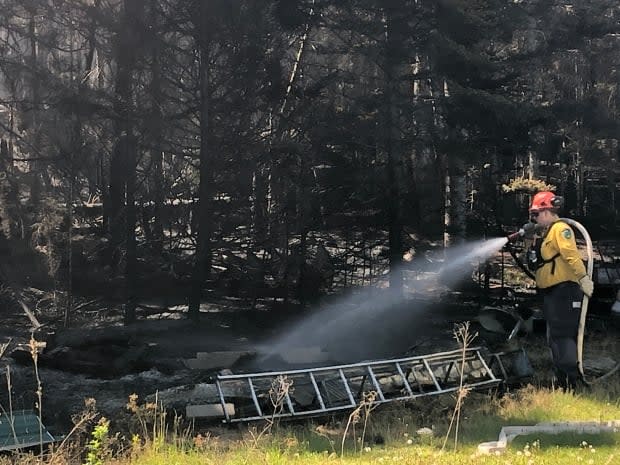From 'hilltop to hilltop to hilltop': residents grapple with impact of fast-moving forest fire

Geoffrey Howson was emotional when he returned to his Bocabec home in southwestern New Brunswick on Tuesday afternoon and realized how close he had come to losing it.
The heavily wooded areas on either side of his long driveway were burned black. Scorch marks almost encircle his house, including in a front flower bed and directly beneath his back deck, which overlooks Passamaquoddy Bay.
Fire burned through a wooded area to within 10 metres of his home on one side.
Howson credits firefighters with saving his house. If not for them fighting off the flames, he's certain he would have lost it.

That scene was being replayed all over the Bocabec and Chamcook areas affected by the fire after officials lifted an evacuation.
He said he's "incredibly grateful" to the firefighters, who worked around the clock to protect homes from the fast-moving fire that began about three kilometres away in the woods across Highway 127 from Howson's house.

Firefighters told Howson they even fought the fire with the garden hose he had lying beside his house.
He heard about the fire from a neighbour on Sunday afternoon and within hours, he and his wife were ordered to evacuate.
While the fire is still considered out of control, officials did allow residents to return.
Howson said he had been running on adrenaline until he got home and started feeling the impact of what they had been through.
He felt vulnerable and "just very, very lucky."
Across Highway 127, Department of Natural Resources officials allowed journalists on Tuesday to get a look at the damage caused by the forest fire.
WATCH | Bocabec resident grateful firefighters saved home from forest fire:
A dirt road led to several properties in the woods.
Very little vegetation was left. Blackened tree trunks were all that was standing along both sides of the road.
Somehow, though, firefighters managed to keep the flames from claiming three modest homes or camps.
Burned vegetation almost surrounded one of the buildings, coming to within feet of the structure. It seemed inconceivable that any of the buildings were still standing.

Firefighters were still on the property dousing hot spots in the nearby woods when one of the homeowners returned.
The man walked around his house and stood to survey the damage. He stood very still until he was overcome by a visible shudder before he continued on around his house.
Only one house was lost in the blaze that claimed about 250 hectares. It's being called the Stein Lake fire because it began on the South Glenelg Road near Stein Lake, around 13 kilometres north of Saint Andrews.
Fire Chief Kevin Theriault said the 911 call reported an ATV on fire. He said by the time firefighters reached the scene, it had already spread to the woods and could not be contained.
Very strong winds on Sunday initially carried the fire parallel to Route 1 before turning south toward Highway 127, said Theriault.
He said the winds were so strong they carried the fire from "hilltop to hilltop to hilltop."

In fact, the fire spread to areas eight kilometres away from the initial fire. At its widest, the fire burned three kilometres across. It jumped across Highway 127 in at least three spots, said Theriault.
By Monday afternoon, he said there were at least six distinct fire locations.
Local MLA Kathy Bockus told a news conference on Tuesday afternoon that aerial surveillance identified 220 hot spots.
More than 60 firefighters from 13 different departments from as far away as Harvey and Oromocto were on scene battling the blaze on Monday.

By Tuesday, Theriault said, that was down to 55 firefighters from eight departments.
Roger Collet, a wildfire management officer with the New Brunswick Department of Natural Resources, said the seven water bombers that flew more than 80 hours on Monday are now on standby.
The fire will now be largely fought on the ground by hand. Bulldozers are being used to clear the way to access the more remote areas and to help create fire breaks.


